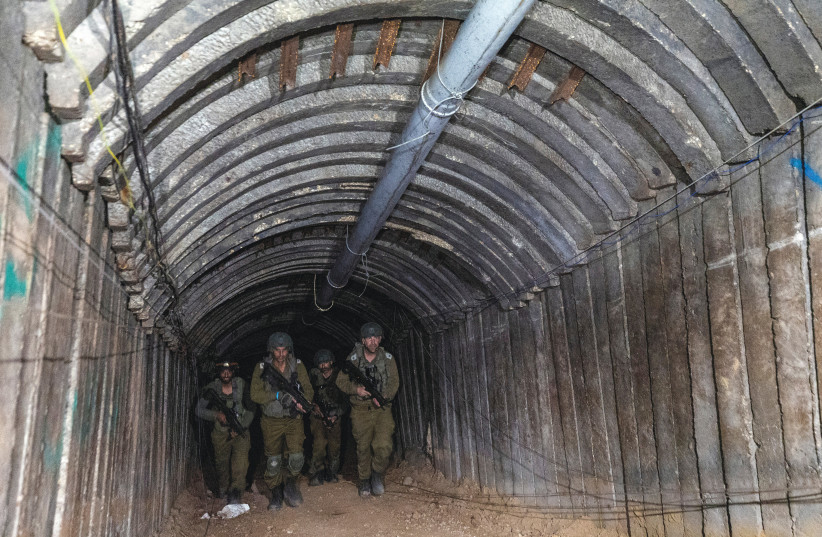Could Israel’s military tactics in Gaza give Hamas a chance to rebuild?
As Israel transitions from “stage 2” of the war against Hamas to the longer “stage 3”, experts warn that a reduction in the intensity of Israel’s campaign could allow the terror organization to rebuild itself militarily in Gaza.
The Institute for the Study of War (ISW) and the Critical Threats Project, American organizations analyzing the IDF’s war in Gaza, released an update to the ongoing Israel-Hamas War on Tuesday, stating that “Israeli forces are transitioning to the third phase of their operations in the northern Gaza Strip, which will very likely enable Hamas to reconstitute itself militarily.
“Israeli forces have degraded several Hamas units and rendered others combat ineffective, particularly in the northern Gaza Strip, since the beginning of the clearing operations,” the report continued. “But Hamas’s military forces are neither defeated nor destroyed at this time. Decreased Israeli pressure would, in fact, allow Hamas to rebuild its military capabilities and infrastructure.”
According to the overall plan of the IDF for the war against Hamas, the third phase includes what has been defined as “raids and remote attacks.” The IDF essentially has operational control over most of the major settlements in Gaza, although fighting still continues in and around Khan Yunis in the south. As part of “stage 3”, raids based on early intelligence will be carried out, and remote attacks will destroy infrastructure in areas where IDF combat troops have finished fighting.

To this end, earlier in December, the IDF’s Division 252 was released from service for the time being, having completed its mission in northern Gaza.
Additionally, it was announced on December 31 that the 551st and 14th Brigades would also be released from active duty.
This scale-back, combined with the success in removing a large part of Hamas’s threats to Israeli civilians, is part of the transition to “stage 3.”
Much of Hamas’s military infrastructure and leadership has been decimated since the Israeli ground invasion of Gaza. Most Hamas military and governmental complexes are now in IDF hands, and the military successfully reduced the firing of rockets from hundreds a day at the beginning of the conflict to minimal. By the end of December, the daily average was minimal.
There has also been much talk in Israel of “the day after” the war, with options including Israeli military governance, a Palestinian Authority-led government, or various other options. Hamas has also declared that it will be needed to be involved in any post-conflict governance of the Strip. Last week, Prime Minister Benjamin Netanyahu reaffirmed that, “In order to talk about the day after, it needs to get here first. Only the IDF will have control.”
“Obviously, the Strip will be demilitarized. There will be no power except Israel,” said Netanyahu. The prime minister also noted that the IDF had eliminated over 8,000 Hamas terrorists.
Israel’s military failures give Hamas a chance
However, Israel’s failure to capture or kill the main leaders of Hamas in Gaza, Yahya Sinwar and Mohammed Deif, plus the continued failure to locate and return the 133 remaining hostages in Hamas’s hands, has led to fears that the longer the situation continues, the less successful the IDF will be overall. The longer Sinwar is able to continue avoiding detection in the subterranean tunnel complex Hamas has under Gaza, allegedly accompanied by several of the Israeli hostages, the longer he is able to direct the campaign against Israel.
The ISW and Critical Threats report also notes that despite Israel’s success in killing many Hamas military commanders, there is no reason that successors should not have been planned and developed.
“Hamas maintains a conventional military structure, meaning that it should be able to quickly replace commanders who have died in the war,” the report states. “Several recently killed Hamas battalion and brigade commanders had led their units for many years, suggesting that they had the ability and time to develop successors to take their place. Such reconstitution is inconsistent with the stated Israeli war aims, which are to destroy Hamas militarily and politically.”
Ultimately, it would appear that while Israeli success in removing Hamas from power appears inevitable, its stated goal of destroying the terror may be far from certain, and the longer the military campaign goes on, the better the chance Hamas will have to survive and rebuild.
Yonah Jeremy Bob contributed to this article.





Comments are closed.